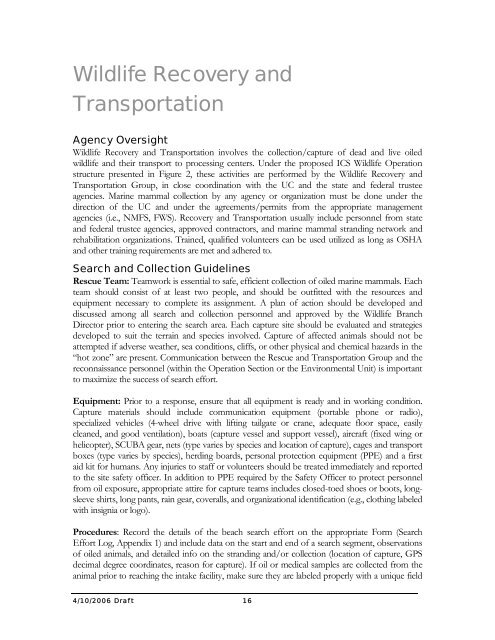Volume III, Appendices EM - National Marine Fisheries Service ...
Volume III, Appendices EM - National Marine Fisheries Service ...
Volume III, Appendices EM - National Marine Fisheries Service ...
You also want an ePaper? Increase the reach of your titles
YUMPU automatically turns print PDFs into web optimized ePapers that Google loves.
Wildlife Recovery and<br />
Transportation<br />
Agency Oversight<br />
Wildlife Recovery and Transportation involves the collection/capture of dead and live oiled<br />
wildlife and their transport to processing centers. Under the proposed ICS Wildlife Operation<br />
structure presented in Figure 2, these activities are performed by the Wildlife Recovery and<br />
Transportation Group, in close coordination with the UC and the state and federal trustee<br />
agencies. <strong>Marine</strong> mammal collection by any agency or organization must be done under the<br />
direction of the UC and under the agreements/permits from the appropriate management<br />
agencies (i.e., NMFS, FWS). Recovery and Transportation usually include personnel from state<br />
and federal trustee agencies, approved contractors, and marine mammal stranding network and<br />
rehabilitation organizations. Trained, qualified volunteers can be used utilized as long as OSHA<br />
and other training requirements are met and adhered to.<br />
Search and Collection Guidelines<br />
Rescue Team: Teamwork is essential to safe, efficient collection of oiled marine mammals. Each<br />
team should consist of at least two people, and should be outfitted with the resources and<br />
equipment necessary to complete its assignment. A plan of action should be developed and<br />
discussed among all search and collection personnel and approved by the Wildlife Branch<br />
Director prior to entering the search area. Each capture site should be evaluated and strategies<br />
developed to suit the terrain and species involved. Capture of affected animals should not be<br />
attempted if adverse weather, sea conditions, cliffs, or other physical and chemical hazards in the<br />
“hot zone” are present. Communication between the Rescue and Transportation Group and the<br />
reconnaissance personnel (within the Operation Section or the Environmental Unit) is important<br />
to maximize the success of search effort.<br />
Equipment: Prior to a response, ensure that all equipment is ready and in working condition.<br />
Capture materials should include communication equipment (portable phone or radio),<br />
specialized vehicles (4-wheel drive with lifting tailgate or crane, adequate floor space, easily<br />
cleaned, and good ventilation), boats (capture vessel and support vessel), aircraft (fixed wing or<br />
helicopter), SCUBA gear, nets (type varies by species and location of capture), cages and transport<br />
boxes (type varies by species), herding boards, personal protection equipment (PPE) and a first<br />
aid kit for humans. Any injuries to staff or volunteers should be treated immediately and reported<br />
to the site safety officer. In addition to PPE required by the Safety Officer to protect personnel<br />
from oil exposure, appropriate attire for capture teams includes closed-toed shoes or boots, longsleeve<br />
shirts, long pants, rain gear, coveralls, and organizational identification (e.g., clothing labeled<br />
with insignia or logo).<br />
Procedures: Record the details of the beach search effort on the appropriate Form (Search<br />
Effort Log, Appendix 1) and include data on the start and end of a search segment, observations<br />
of oiled animals, and detailed info on the stranding and/or collection (location of capture, GPS<br />
decimal degree coordinates, reason for capture). If oil or medical samples are collected from the<br />
animal prior to reaching the intake facility, make sure they are labeled properly with a unique field<br />
4/10/2006 Draf t 16
















